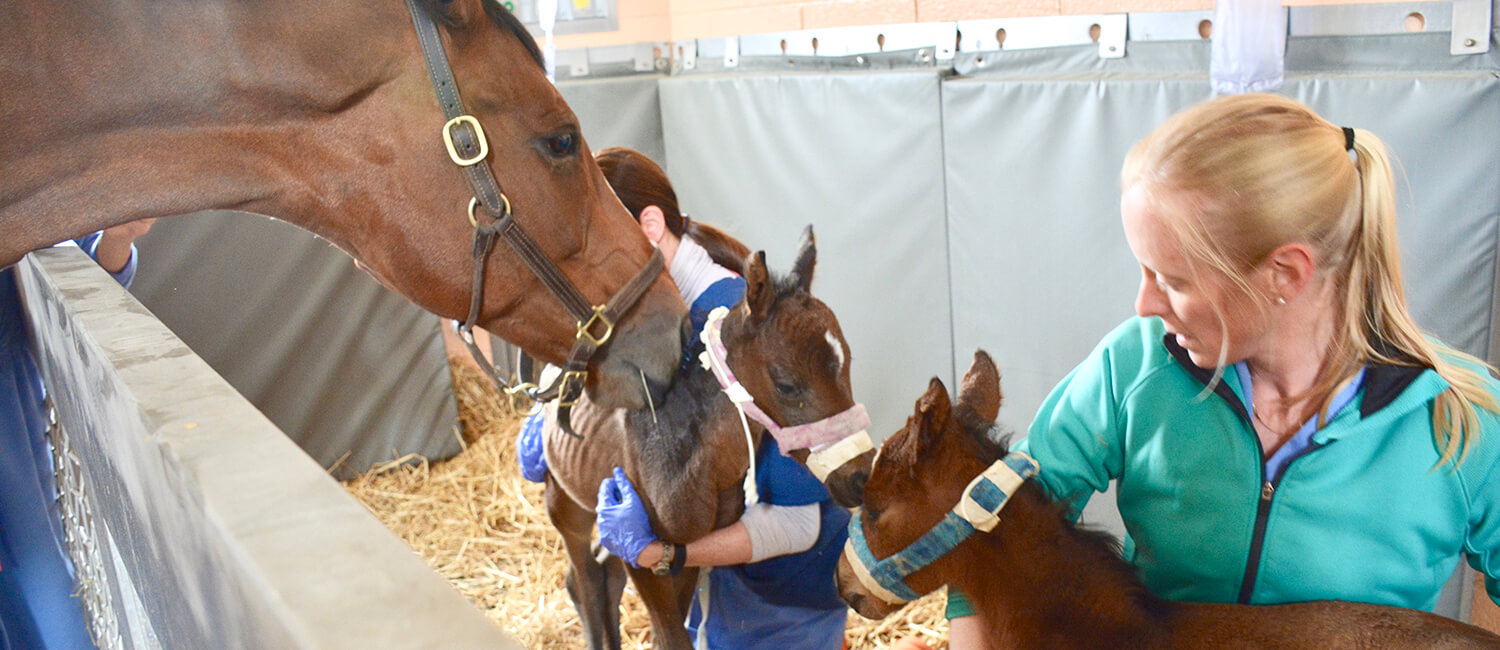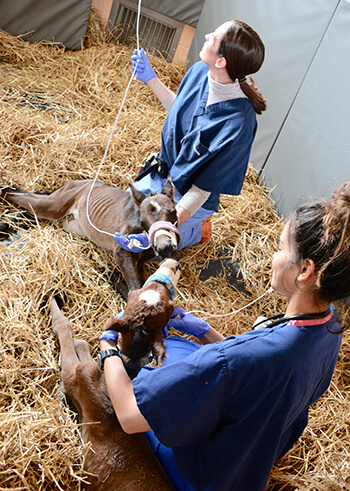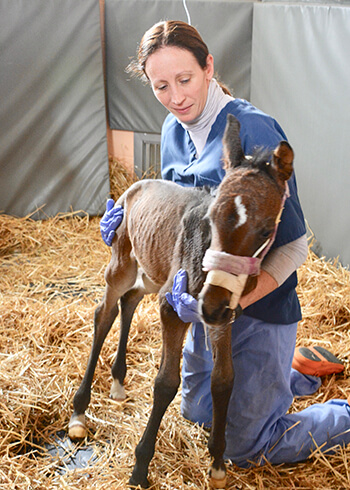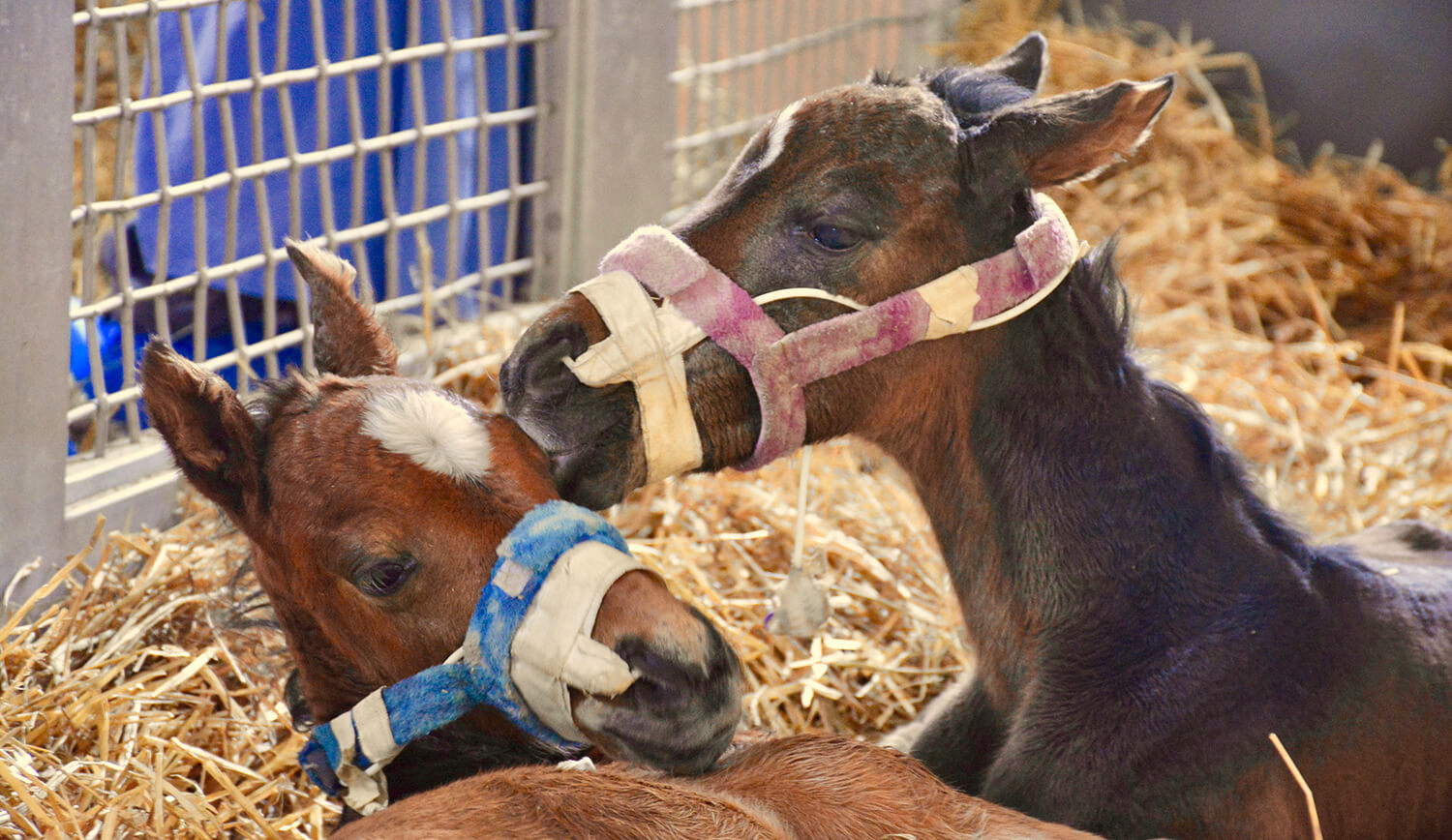
by Sacha Adorno
Excitement over a first pregnancy turned to concern for owner Adel Dukes Melson when her pregnant Holsteiner began showing signs of premature foaling. Weeks before the mare’s March 13 due date, her mammary gland started to develop and secrete milk, a typical indication that her body was preparing to soon give birth.
On February 19, Owner and horse traveled two hours from their home in Bethany Beach, Delaware to Kennett Square, arriving at New Bolton Center’s Emergency & Critical Care department at 8:30 PM.
There, they met Dr. Michelle Linton, Staff Veterinarian, Neonatal Intensive Care specialist, and part of Penn Vet’s High Risk and Healthy Mare Foaling programs.
That night, Linton and her team performed a physical exam, transrectal ultrasound, and fetal heart rate test. The next morning Treasure received an abdominal ultrasound to assess the fetus, uterus, and placenta.
Linton was expecting to find placentitis, the most common reason for premature mammary gland development and a potentially life-threatening condition for mare and foals.
“Treasure came in as a likely placentitis case, and we treated her as one,” Linton said. “But her uteroplacental measurements were normal, suggesting we were maybe dealing with something more.”
Although the ultrasounds showed one fetus and one heartbeat, Linton suspected Treasure might be carrying twins, which could also explain early udder development – and which, surprisingly, can be easy to miss in prenatal exams. She admitted the mare — 317 days pregnant at this point — to the Neonatal Intensive Care Unit (NICU) for monitoring and rest. Over the next few weeks, Treasure grew bigger and bigger but didn’t go into labor.
Four Legs... Then Four More
Finally, on March 13, Linton’s suspicions were confirmed.
At 338 days of gestation, Treasure began foaling. At 9:00 AM, the mare gave birth. Not once, but twice.
“As soon as I saw the legs, it was obvious the foal — a filly — was very small,” Linton recalled. “And pretty much straight away this first set of legs was followed by a second set of legs belonging to a colt.”
Treasure successfully delivered twins — Melson named the filly Cherish and the colt Cache.

“Twins can be hard to diagnose during late gestation,” explained Linton. “The bodies were aligned in utero so we could only visualize one thorax and heartbeat.
While Linton triaged care of two foals, Melson, who had left home as soon as she got the labor call, was just arriving at New Bolton.
“There was a special buzz in the hospital. Dr. Linton came out to meet me with a big grin on her face but waited to tell me anything,” Melson laughed. “When I got to Treasure, I saw the two amazing little foals. Treasure was absolutely beaming and thrilled with herself. I was shocked.”
Rare Case All Around

Treasure and her duo is a rare case. In horses, twin fetuses are uncommon. Carrying them to term is even more unusual, and birthing healthy twin foals is especially unlikely.
“Twin pregnancies are extremely undesirable in horses, as they almost always have a bad outcome,” said Dr. Regina Turner, Associate Professor of Reproduction and Chief of the Reproduction & Behavior Service. “If allowed to progress through gestation, twin pregnancies almost always end in late-term abortion of both foals, or the birth of small, growth-retarded foals that either are born dead or severely compromised.”
Fortunately, this isn’t the situation for Cherish and Cache. Though small at birth — about 49 pounds for Cherish and 47 for Cache — both were born healthy to a mare that Linton said, “is a great mother, and cut out for the job.”
“With twins, our immediate concern is the strength of their lungs and kidneys – are the organs mature enough and functioning properly?” explained Linton. “We also worry about whether their carpal (knee) and tarsal (hock) bones have ossified completely. The cuboidal bones, which are small bones located in those joints, are the last to make the conversion from cartilage to bone. Incomplete ossification of cuboidal bones can lead to collapse of the joints and degenerative joint disease.”
Cherish’s and Cache’s organs checked out fine. The main problem, explained Linton, was the foals’ size. “Even though Treasure carried them to term, they had in utero growth restriction. Initial X-rays confirmed incomplete ossification of the carpal and tarsal bones in both foals.”
The foals had to be kept quiet and off their feet to encourage proper bone growth. Strictly confined, they’ve remained with Treasure at New Bolton Center. The three horses are under the careful, round-the-clock watch of the NICU team and foal sitters, volunteers who assist clinicians and staff in caring for mares and foals during the foaling season.

Slowly but surely, the twins’ bones are ossifying, and they’re able to increase activity, such as having supervised nursing sessions with Treasure.
They’re also gaining weighed — Cherish is up to 123 pounds and Cache weighs 114 pounds —and getting stronger every day. Linton expects they’ll go home soon.
All Hands on Deck
Playful from almost day one, it hasn’t been easy to keep the feisty twins calm while their bodies grow.
“They have become so rambunctious, up and down all the time,” said Melson. “Initially, we had to discourage them from standing, but since they worked out how to stand, the care team has had its hands full!”
In the meantime, Melson’s shock at having twins has now given way to pure joy and gratitude that Treasure delivered two thriving foals. (Melson started a Facebook page to share their growth and antics.)
“Treasure and the twins are receiving excellent care from a wonderful team. At every stage, the veterinarians, students, and staff have been very hands-on. Everyone cares so much about mom and her foals,” Melson commented. “New Bolton is very special place.”
Update
As of 6:45 am this morning, Treasure and her twins are doing fine!

This article originally appeared online from The University of Pennsylvania School of Veterinary Medicine New Bolton Center and is re-printed here with permission. Find out more about Equine Heatlh & Education right here on EIE.

































